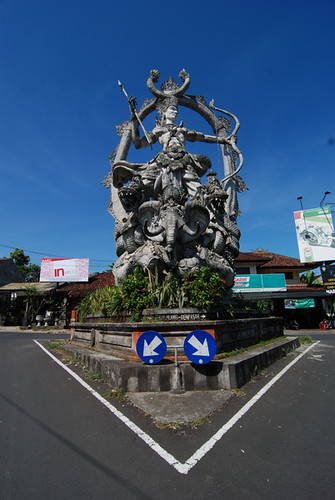The Japanese aesthetic sense has always fascinated me. I can't help it. Japanese folk music, some Japanese popular music like jazz and classic rock, old Japanese art and Japanese literature and quite a few anime/manga seemed to embody this concept. I used to think this fascination was weird, because almost no one else shared it, but then as I grew older I found a few others who did. But by then it didn't matter too much to me because I didn't really need acceptance of it anymore. I was happy about it and I treasured it.
Recently, I read an article on Wikipedia about it. This Japanese world view is called
Wabi-sabi (佗寂 in kanji) and was heavy influenced by Chinese and Indian Mahayana Buddhist philosophies (mainly Chinese) and is meant to embody the 3 marks of existence according to Buddhism - impermanence, suffering, and emptiness/absence of self nature.
These are recurring themes in Zen Buddhism (the predominant Buddhist
school of thought in Japan) and apparently characteristics of this world view include "asymmetry, asperity
(roughness or irregularity), simplicity, economy, austerity, modesty,
intimacy and appreciation of the ingenuous integrity of natural objects
and processes."
Well, I've always admired it silently, so I never really had to give it a name or defining characteristics, but when presented with them, I find that I agree with them wholeheartedly!
While looking around at the nearby library, I found a whole section on Indian and East Asian philosophies, of different kinds - modern, secular, "Hindu", Buddhist, Taoist, Confucian and others. But mainly "Hindu" (Indic is the term I prefer) and Buddhist. Reading these books in all that silence, with very little people sitting around, gave me a very pronounced wabi sabi-ish feel, that I really enjoyed. I made it more intense by simultaneously listening to music like jazz, jazz fusion and Hindustani music (I'm listening to Shivkumar Sharma's Hindustani santoor music while typing this!)
Now, after all these years of enjoying this and picturing similar ideas in my head, I'm gonna give a shot at my own wabi sabi sorta stuff. For this I've decided to try starting with haiku - a Japanese poetic style that was based on wabi sabi and Zen minimalism. Popularized by English writers, its features include a total count of 17 syllables, usage of "season words" and lots of simplicity and imagery.
I had this sudden flow of ideas and came up with a few. I decided to go against my punctuation perfection mini OCD and write without any punctuation (except for commas, for breaks). It was very hard to fight against, but in the end was strangely liberating(!)
~
moonlight shining down
himalayas in full bloom
winter nights are here
~
This is is based on this mental image of the Indian/Tibetan Himalayas. The serenity of mountains has always had a special place in my mind.
~
silence and flowers
meditation in springtime
down in the valley
~
This is based on a mental image of The Valley of Flowers in India. And also, the temple city of Badrinath in Himalayan India, which is situated at an elevation of around 3,700 m above sea level (!!) Mountains have their own appeal. It's one of the places where nature is at it's strongest. No wonder the ancient Indian Vedic and Buddhist people claimed that the Himalayas were the abode of the gods and the place in the world with the most concentrated spirituality in them.
~
beaches and date palms
with glasses of lemonade
- my perfect summer
~
This is based on mental images of Goan beaches and the Malabar coast. Goa especially is like India's own Rio, with it's decades of hippie culture, alcohol, beach houses, parties, foreign tourists, and history of hundreds of years of laid back Latin lifestyles.
~
kailash in tibet
towers above the mundane
icy, lucid, peace
~
This was with Mt. Kailash in mind, a sacred mountain in Indian religions. The area around it is largely uninhabited, adding to the calm.
~
shlokas and farm life
- om mani padme hum
- glimpses of tibet
~
This was with Ladakh in mind. Ladakh is a region of Kashmir, India that is different from most of the rest of India in the respect that its culture is derived from Tibetian culture, and not Aryan culture as is the case in the rest of India (Except the south and some north east states). Though Ladakh isn't unique in that aspect - Some parts of Arunachal Pradesh and Sikkim in the north east have Tibetian peoples. Tibet itself is plagued with political instability and is pretty hard to get to travel in, so Indian Tibetan cultures are the closest I can get to that experience. And Ladakh is the most best place for that. Even today, you'll find Tibetan Buddhist monasteries and monks and prayer wheels and what not there. The traditional Tibetan life lives on.
~
forests and beaches
men sheltered in the three jewels
- the land of lanka
~
Last year, I had the fortune to get to visit Kandy and Colombo in Sri Lanka. It was a great experience and I loved it. It was superficially very similar to India, especially Tamil Nadu, but then after digging a bit I found it unique in its own way. The population isn't as insanely high, so the cities are very very free and nice to roam around in, and they have their own sense of calm, which calls to the mind a sorta Buddhist - Latin feel.
That's it for now. But I have plans to extend these ideas, into music, and maybe if I find a like minded person to draw, some art also.
Let's see.

